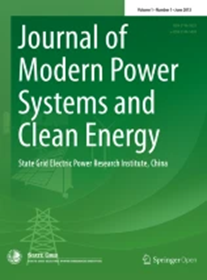Low-Frequency Oscillations and Resonance Analysis of VSG-Controlled PMSG-based Wind Generation Systems
IF 6.1
1区 工程技术
Q1 ENGINEERING, ELECTRICAL & ELECTRONIC
Journal of Modern Power Systems and Clean Energy
Pub Date : 2024-10-24
DOI:10.35833/MPCE.2024.000465
引用次数: 0
Abstract
With good adaptability to weak power grids, the grid-forming inverter becomes the foundation of future power grids with high-proportion renewable energy. Moreover, the virtual synchronous generator (VSG) control is recognized as the mainstream control strategy for grid-forming inverters. For permanent magnet synchronous generator (PMSG) based wind generation systems connected to power grid via VSG-controlled grid-forming inverters, some novel impacts on the low-frequency oscillations (LFOs) emerge in power grids. The first impact involves the negative/positive damping effect on LFOs. In this paper, the small-signal torque model of VSG-controlled PMSG-based wind generation systems is established based on the damping torque analysis method, revealing the influence mechanism of machine-side dynamics on LFOs and proving the necessity of the double-mass model for accurate stability analysis. The second impact is the resonance effect between torsional oscillation and LFOs. Subsequently, this paper uses the open-loop resonance analysis method to study the resonance mechanism and to predict the root trajectory. Then, a damping enhancement strategy is proposed to weaken and eliminate the negative damping effect of machine-side dynamics on LFOs and the resonance effect between torsional oscillation and LFOs. Finally, the analysis result is validated through a case study involving the connection of the VSG-controlled PMSG-based wind generation system to the IEEE 39-bus AC grid, supporting the industrial application and stable operation of VSG-controlled PMSG-based wind generation systems.vsg控制的pmsg风力发电系统低频振荡与共振分析
成网逆变器对弱电网具有良好的适应性,成为未来高比例可再生能源电网的基础。此外,虚拟同步发电机(VSG)控制已被公认为成网逆变器的主流控制策略。基于永磁同步发电机(PMSG)的风力发电系统通过vsg控制的并网逆变器并网,对电网的低频振荡产生了一些新的影响。第一个影响涉及对lfo的负/正阻尼效应。本文基于阻尼转矩分析方法,建立了基于vsg控制的pmsg风力发电系统的小信号转矩模型,揭示了机侧动力学对LFOs的影响机理,证明了双质量模型对精确稳定性分析的必要性。第二个影响是扭转振荡与lfo之间的共振效应。随后,本文采用开环共振分析方法研究了共振机理,预测了根轨迹。然后,提出了一种阻尼增强策略,以减弱和消除机侧动力学对lfo的负阻尼效应以及扭转振荡与lfo之间的共振效应。最后,通过vsg控制的pmsg风力发电系统与IEEE 39总线交流电网连接的案例研究,验证了分析结果,支持了vsg控制的pmsg风力发电系统的工业应用和稳定运行。
本文章由计算机程序翻译,如有差异,请以英文原文为准。
求助全文
约1分钟内获得全文
求助全文
来源期刊

Journal of Modern Power Systems and Clean Energy
ENGINEERING, ELECTRICAL & ELECTRONIC-
CiteScore
12.30
自引率
14.30%
发文量
97
审稿时长
13 weeks
期刊介绍:
Journal of Modern Power Systems and Clean Energy (MPCE), commencing from June, 2013, is a newly established, peer-reviewed and quarterly published journal in English. It is the first international power engineering journal originated in mainland China. MPCE publishes original papers, short letters and review articles in the field of modern power systems with focus on smart grid technology and renewable energy integration, etc.
 求助内容:
求助内容: 应助结果提醒方式:
应助结果提醒方式:


